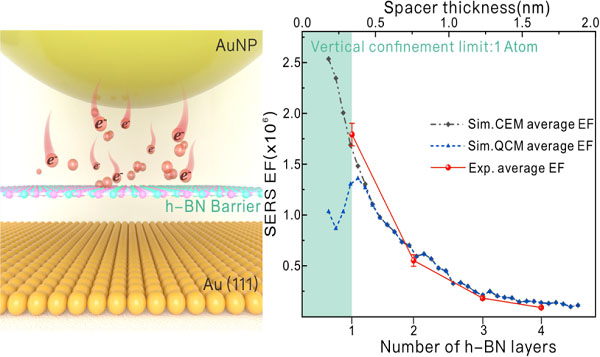| Apr 24, 2023 |
Expanding plasmonic enhancement limits with hexagonal boron nitride
(Nanowerk News) A study spearheaded by Professor Yang Liangbao from the Hefei Institutes of Physical Science at the Chinese Academy of Sciences discovered that hexagonal boron nitride (h-BN) effectively inhibits electron tunneling, thereby extending the ultimate plasmonic enhancement boundaries in single-atom-layer gaps. This breakthrough offers valuable insights into quantum mechanical phenomena within plasmonic systems and paves the way for innovative applications in the realm of quantum plasmonics.
|
|
The findings were published in the journal Nano Letters ("Extending Plasmonic Enhancement Limit with Blocked Electron Tunneling by Monolayer Hexagonal Boron Nitride").
|
 |
| Schematic of a monolayer h-BN as hot-electron tunneling barrier (left); Change of volume-averaged SERS enhancement factor with the gap size (e.g., number of h-BN layers) (right). (Image: CHEN Siyu)
|
|
The team has dedicated years to developing surface-enhanced Raman spectroscopy (SERS) detection techniques, noting that the near-field intensity distribution is non-uniform at the nanoscale. To achieve higher electromagnetic enhancement, they employed adjacent metal nano-gaps but observed that decreasing their size resulted in the undesired emergence of a quantum tunneling effect, which hindered SERS detection.
|
|
To address this issue, the researchers introduced a high tunneling barrier composed of a monolayer of h-BN, which successfully obstructed the electron tunneling effect. They then quantitatively measured the ultimate near-field enhancement limit within the classical framework by assessing the intrinsic SERS intensity of h-BN in a single particle cavity.
|
|
The investigation demonstrated that a monolayer of h-BN impedes electron tunneling through hot electron tunneling quantum computation and layer-dependent scattering spectrum experiments. By comparing experimental data with the calculated outcomes of the classical electromagnetic model and the quantum correction model, the team achieved the detection of the ultimate near-field enhancement limit within the classical framework.
|
|
This study offers crucial guidance for quantum plasmonics and nano-gap photodynamics, and contributes to a deeper understanding of quantum mechanical effects in plasmonic enhancement.
|

